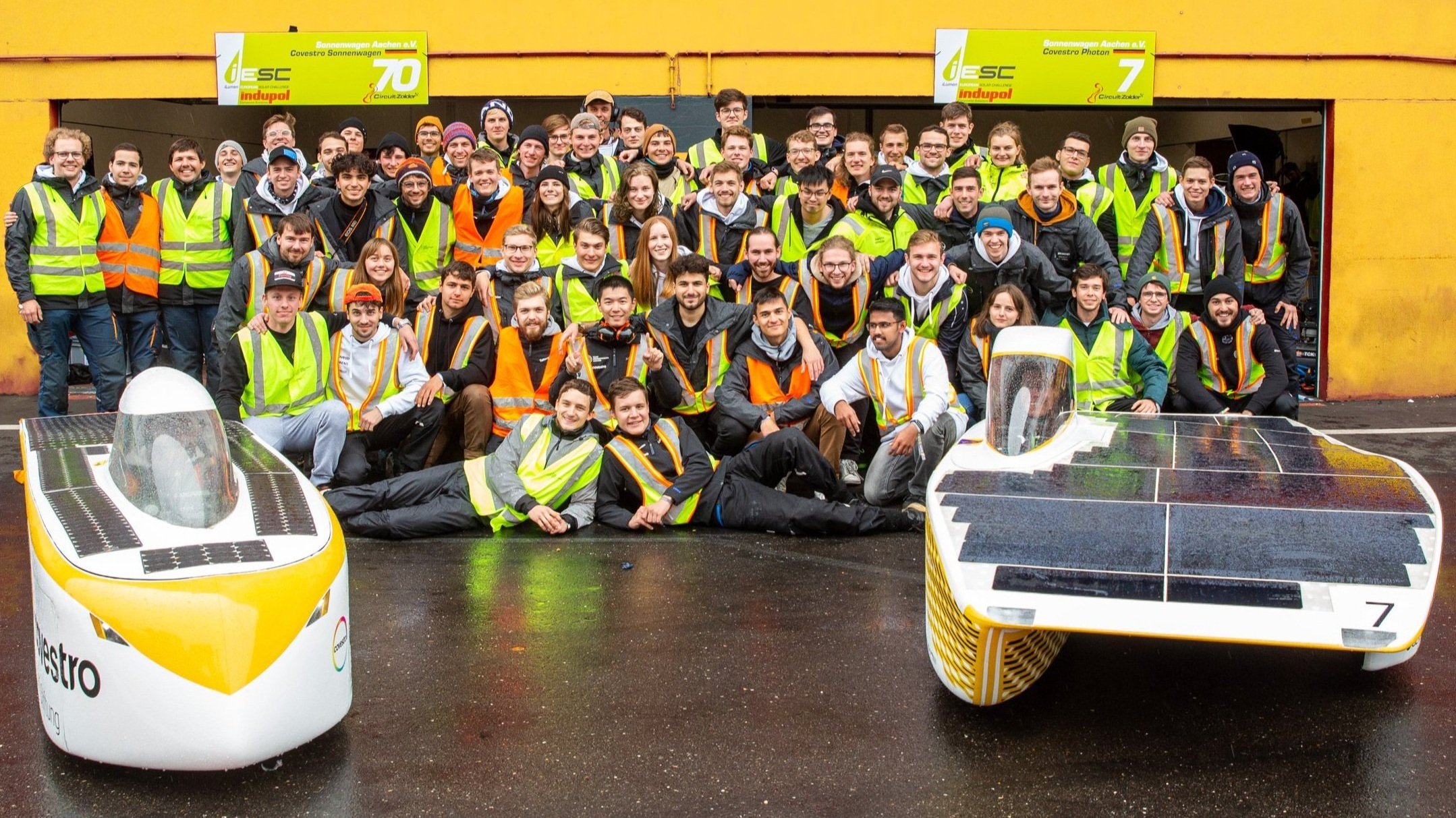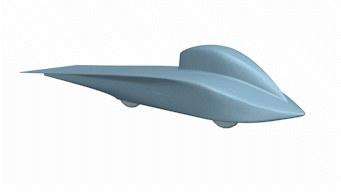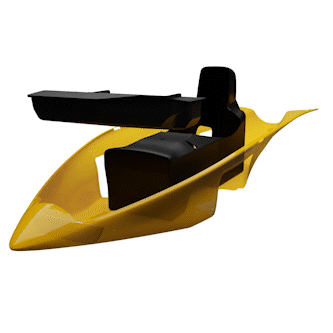
Covestro Adelie
After two years of development and manufacturing, we are proud to present the fourth generation of our Sonnenwagen, Covestro Adelie. The aim was to develop the most efficient design the team has ever produced. One of the innovations is the exterior which is optimized for aerodynamic efficiency, inspired by the Adelie penguin.
2023
Build year
Mono-Si cells
Type of solar cells
>6 kWh
Lithium iron phosphate battery pack
136 km/h
Top Speed
4 m²
Area of the solar array
3
Number of wheels
<170 kg
Total weight
25 %
Efficiency of the solar cells
self developed
Inverter
ROLLOUT.
5. June 2023, 5.30 pm
Eurogress Aachen

Technical highlights.
Aerodynamics
The first step in the development of Covestro Adelie was the so-called concept decision.
Are we building a catamaran construction again, like in 2021 (Covestro Photon), or a bullet design? This decision would largely determine the outer shape of Covestro Adelie. After much discussion, we decided on the bullet design.
Now the detailed work for the exterior design could start. While some tried out new models creatively, others simulated these models in CFD (Computational Fluid Dynamics). The challenge here was to minimize air resistance. Because that's exactly what efficiency means to us: Reducing energy consumption to the minimum. 600 models and more than 200,000 computational hours for the simulations later, the optimal exterior model for Covestro Adelie had been determined.
Evolution of Covestro Adelie
Structure
Once the aerodynamics team had created an optimised model, it had to be laid out for mechanical stability and broken down into components that could be manufactured. To do this, our structural team simulated and designed the components from which Covestro Adelie would be assembled. We were faced with three major challenges: Minimum installation space, sufficient safety for the driver and lightweight construction.
The available space is limited on the one hand by the PVC pat prescribed in the regulations, which must fit into Covestro Adelie in the end. And on the other hand by the dimensions specified by the aerodynamics department.
Exploded view of the structural components
In order for Covestro Adelie to provide adequate safety for our drivers, we have come up with integrated designs in the monocque. For example, our carbon fibre roll bar is part of the monocoque. And the monocoque is also part of the outer shell.
This year we have realized a weight reduction of more than 16% compared to Covestro Photon. This is the result of advanced materials and high-performance manufacturing methods. This was for example, the Prepreg Sandwich Layup we used and Alumium 3D printed mechanisms.
"Over 10,000 workshop hours, around 70 milled parts and half a year later: Covestro Adelie's body is manufactured! "
—Finn Möller-Boldt, Head of Structural Components 2023
Electrical engineering
Without the electrical components in Covestro Adelie, the battery electric solar car would not be able to move. Our electrical engineering department is responsible for the battery, inverter, motor, solar cells, telemetry and lights.
We get our energy from the solar cells on the top of Covestro Adelie. The 567 mono-Si cells are wired to cover 96% of the total surface area. The arrangement and placement of the solar cells is optimized for solar radiation and and to avoid any shadows caused by the canopy.
Battery pack stored in Covestro Adelie
The generated solar energy is fed into our self-built battery. The battery pack is able to store more than 6kWh. The shape of the battery has been uniquely adapted to the shape of Covestro Adelie in order to fit the largest possible battery into the smallest possible space.
Either directly from the solar cells or from the battery, the energy is fed to the drive train. Here, the direct current must first be converted into an alternating current. This is done by our inverter. In order to lose as little energy as possible during this process and to optimally adapt it to our energy needs, we have been developing our own inverter since 2018. The Ganti. It is now ready to be used in Covestro Adelie. Finally, the energy is fed to our self-built wheel hub motor. There, the self-generated energy is brought directly to the road!
"For comparison: with a battery capacity of 6kWh, series electric cars reach 60km of range. We can do 600km, and that's without solar cells."
- Max Haupt, Co-Head of Electrical Engineering 2023
Mechanical engineering
A solar car without wheels, steering, and brakes does not drive! That is what we have our chassis team for. Our challenge was to determine the wheel span of the Covestro Adelie. This had to be designed to the precise millimeter between the minimum and maximum possible. In order to keep the air resistance as low as possible, we had to minimize the wheel span. At the same time, the solar car had to be stable and safe and the wheel span had to be maximized.
Optimizing the center of gravity played a crucial role in this. Why is this so important for us? A low center of gravity and a wide track width contribute to stable handling. Constrained by heavy components, such as the battery, we determined our minimum possible center of gravity position.
Schematic structure of the suspension
Another restriction for the wheel span was the available installation space to avoid collisions of components. The width of the monocoque, the required movement in the steering system and the steering angle of the wheel as well as the compression and rebound kinematics of the wheel suspension were of great importance.
In order to make optimum use of the small installation space in Covestro Adelie, we use at several places complex titanium-milled parts for the chassis.
"For the first time we used the Simcenter Motion multi-body simulation software. By precisely analyzing the movements and forces, we ensured that all parts interact optimally and move harmoniously without interfering with each other."
- Tom Keuser, Head of Mechanical Engineering 2023
Driving Strategy
Building an outstanding solar car is not enough to win the Bridgestone World Solar Challenge in Australia. We, as strategists, make sure that we get the maximum performance out of our solar car. The aim is to drive in the most efficient way and use wind weather and hills to our advantage. During the race, the driving strategy is at the heart of all important decisions in and around the solar car. Primarily, we are responsible for managing the available energy as efficiently as possible in order to be the first to cross the finish line in Adelaide. To achieve this, we have a number of tools, which are carefully developed in the months leading up to the challenge. Among the most important is the live transmission system of the solar car's data. The self-developed optimization software is running on a thoroughly tuned and tested digital car model. In order to be able to react to the challenges of the day, the Driving Strategy collects data from several sources, such as weather stations, GPS systems, and a detailed weather forecast received via a satellite internet connection.
"This year, we aim to push our projects to the next level of reliability and resilience. We hope to be able to anticipate any potential race situation when it counts in Australia and ultimately gain an advantage over the rest of the competition."
- Felix Meyer, Head of Driving Strategy 2023











